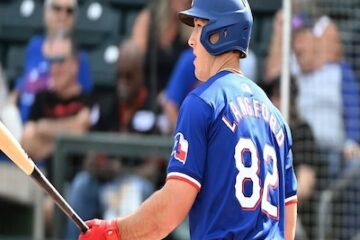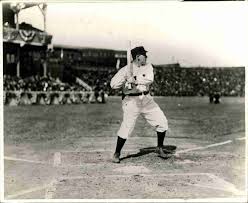2014 Fantasy Baseball: Too Early Top 10 RP for 2014
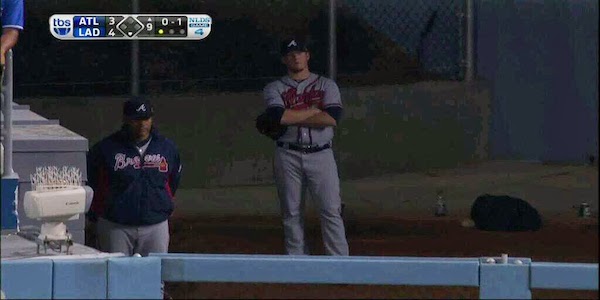
Ah, we’re at the end of the road – for now. We’ve taken a look at every position around the diamond so far from a fantasy perspective next season. For the sake of readers who want/need to re-read or catch up on here are the previous pieces: catcher, first base, second base, shortstop, third base, outfield I, outfield II, starting pitchers I, & starting pitchers II.
Relief pitchers are fickle. If you’re reading sites like ours, there’s a pretty solid chance you already knew that. In fantasy though, we mainly only care about the 30+ guys that are in line to get save opportunities. Fortunately, or perhaps unfortunately, “closers” are just as fickle as their other bullpen counterparts. It’s what makes the position so fun to watch in during the season because everyone is always searching for a new closer once theirs blows up and has 6 ERA one month and has his job taken from him.
I’ll do my best to rank my top 10 below without advocating my own personal draft strategy too much. Hint: I don’t pay for saves. The top 10 is based on a number of factors, but the main few are pretty simple: job security, command, and strikeout stuff.
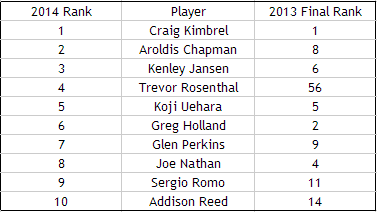
Craig Kimbrel is number one. Despite reaching 50 saves for the first time in his career he actually wasn’t quite as good as he was in 2012. The good news is that he came down from heights we’ve never quite seen before. How is it even possible to lose twelve percentage points of your strikeouts and still strike out 38% of the batters that step in the box? I’m not sure there’s a fair answer to that question. Kimbrel’s the best reliever in baseball and has probably a longer leash than anyone if he does struggle. He’s number 1 without much of a question. The only hope I have going forward for Kimbrel is that I don’t have to see him in the bullpen again watching someone else blow the last game of the season. As far as the picture at the top goes, it’s taken all I can to not riff about how Fredi Gonzalez did not use him correctly in the postseason. It would be cathartic. I’ll just settle for the picture, I guess.
Chapman’s ranking is obviously dependent on his actual presence in the bullpen. It seems like Cincinnati is considering moving him into the rotation again, which if he can handle it makes him more valuable in real-life and fantasy anyways. For now, we’ll leave him in the rankings. Chapman’s K% declined a little bit to 43.4% – what a bum.
The only two knocks on Chapman are his control and his homeritis. Perhaps the HR/FB rate in 2013 is a little fluky considering it was roughly double his 7% rate between 2011 and 2012 combined, but we’ll see. I’m not too worried about it, yet. His other flaw, command, on the other hand, is worrisome. Chapman’s 11.2% (4.10 per nine innings) walk percentage is only sustainable in his role because of his ability to strike out batters almost at will. If he’s throwing strikes he’s nearly untouchable. He’s able to do that more often than not, at the moment, so keep trusting him.
Man oh man, I love Kenley Jansen’s cutter. Aside from Jose Fernandez’s curveball, I’m not sure there’s a pitch in the game I enjoy watching more than Jansen’s cutter.
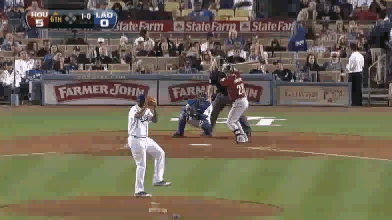
Seriously, look at that. Marvel at it. I’m not even sure how it’s possible to get that much movement on a cutter, unless you’re reading this, Mariano?
All Jansen ever needed was the opportunity to close. He finally got it again half way through the 2013 season and did not disappoint. He even got a little better by cutting his walks down to a career low. It wouldn’t surprise me one bit for him to be ranked the number one closer at the end of 2014 considering he should have plenty of chances to close the door given the Dodgers’ ability to win more games than most teams.
The next two guys are more proof that the “proven closer myth” is hot garbage. Neither of them had closed full time coming into 2013 and guess what? They were closers for the World Series representatives, respectively.
Trevor Rosenthal slots in above Koji Uehara for me, but I’d have no problem switching them. They’re both very, very good. Rosenthal is flame throwing monster , whom I wish the Cardinals would let start, but we’ll save that for another day.
The Cards rode the magical arm of Edward Mujica most of the season once Jason Motte was lost before the season began. Mujica’s work was good, but he’s no Rosenthal and it was only a matter of time before Rosenthal’s ability to blow batters away won out. Rosenthal’s ability to make hitters chase (16th best in the majors among RP) and get hitters to swing and miss in general (7th best) make him one of the most effective bullpen pieces in the game. Job security could be somewhat iffy if Motte comes back healthy and Rosenthal struggles a little, but with his stuff he shouldn’t struggle very much, it at all in 2014.
I was tempted to put Koji up at 3, and perhaps even 2, but I ultimately decided on 5. Ranking these guys is tough! I believe the guys in front of him all have a little more upside in regards to strikeouts, but for what he “lacks” in strikeouts, he more than makes up for command.

Uehara threw a first pitch strike better more often than any other reliever in 2013, except for one. He generated more whiffs than and other reliever. He walked a lower percentage of batters than all but two reliever, which enable to have a .57 WHIP. Not even fair. Koji should have ample opportunities to save games in 2014 and I don’t think his job will be in jeopardy anytime soon.
Whenever I think about Greg Holland, I’m usually brought back to pieces that I read about Craig Kimbrel when he was coming up through the Braves’ system. Fantastic stuff, but lacking command. In 2012, command was Holland’s only real blemish. He was finally able to reign in his pitches a little in 2013. Holland saw his zone% (percentage of pitches in the strike zone) increase about 1.5 percentage points. That’s not terribly impressive, but what was impressive was Holland’s ability to get ahead more consistently. His f-strike% (first pitch strike) vaulted upwards by a staggering 11 percentage points, to 61.2%. That number is more in line with what Holland was able to do in 2010 and 2011 when he burst onto the scene rocking those sweet powder blue uniforms. Holland’s strikeout percentage climbed as well, in part due to his ability to get ahead of hitters more often. Trust him going forward.
Glen Perkins is a personal favorite of mine, in part, because he’s one of the most cerebral players that the game has. He is very accepting of new age stats and uses them to both gauge his performance and find areas for improvement in his game. Now that my praise for not calling people like myself “nerds” is out of the way, let’s assess Mr. Perkins. Despite not being a “proven closer” Perkins put together a fantastic season in 2013. He was essentially who he’s always been, except with a few more strikeouts. He’s left-handed, and while that makes some nervous due to the fact that most opposing batters will have a platoon advantage against him, it doesn’t seem to affect his ability to close out games in the slightest. Throughout his career right-handed batters only fare better than left-handed batters by .10 wOBA (weight on-base average) points. In other words, don’t worry about platoon splits when it comes to Perkins. He’s a good pitcher with a solid grasp on his job.
To paraphrase Eno Sarris, “when Joe Nathan’s velocity is good, he’s good, when it’s not good, he isn’t.” Nathan’s relatively safe, his fastball velocity is key for him, perhaps more so than other pitchers, so watch that closely if he struggles. The Tigers’ willingness to commit to him for a relatively large contract over 2 years should tell you all you need to know about his job security.
I’m not quite sure why Giants’ fans get have all the fun. They get to root for “Kung-Fu Panda” and call themselves “Romosexuals.” It just seems greedy to have both of those. Anywho, Sergio Romo, was fantastic again last year. Once again, his slider carried most of the load. Romo threw his slider roughly 50% of the time in 2013 – sixth most among relievers. I don’t blame him, because it is a fantastic pitch. Work done by Jeff Zimmermann, however, tells us that pitchers who rely heavily on their sliders are much more likely to get hurt, so it’s definitely something to monitor with Romo going forward. Until signs of a breakdown show themselves, though, Romo should be relied upon again in 2014.
I went back and forth a little on who I should slot into the 10 spot in rankings. No one exactly stood out. I ended up choosing Addison Reed over Casey Janssen, ultimately because I believe he has more of an upside due to his ability to coax opposing batters into swinging and missing more often.
Reed isn’t without flaws, though. He’s a flyball pitcher and we all know that can become an adventure, especially when half of your games are played in “The Cell.” So far, Reed’s been able to keep the ball in the yard more often than not, so hopefully the trend continues in 2014. The White Sox, as currently constructed, might not win very many games, but Reed should be called on to close the majority of those wins out.
I hope you’ve enjoyed the series of rankings I’ve put together. Feel free to follow me on Twitter (@joneslandon) and talk some baseball.



